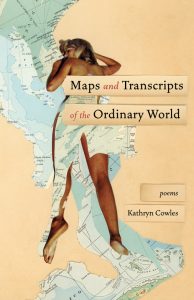Book Review
Maps and Transcripts of the Ordinary World attempts to document the interstitial moments that serve as the gaps between what is deemed memorable or significant in our lives. Through this act of quotidian documentation, Kathryn Cowles both affirms the drive to preserve such ephemera and understands that temporality cannot last. Using both written and visual collage poetry, this collection serves as a physical reminder of the ways we both move in the world and how the world moves around us, evoking remembrance while veering away from nostalgia. Like a meditation, Cowles’s poems ask the reader to remain present through these moments with the speaker in mapping time and space.
Interwoven throughout are visual poems that open and close sections of the collection. These visual poems, some titled “Map,” employ word collage layered on top of photographs of seemingly everyday scenes and objects, where the typed words are often repetitive and explanatory of the image. In one photograph of a stucco storefront with barred windows and shuttered doors, the collaged text reads, “this is a world the size of a world,” asserting its own tautology when viewing the image. Yet this repetition, like all of the repetitions within the collage poems, asks the reader to pay attention to how language represents these spaces within the photograph, which is itself a reproduction.
This futility to reproduce the unreproducible is at the heart of Maps and Transcripts of the Ordinary World; the speaker uses brief, fragmentary moments to provide glimpses into the redundancies of domestic life. Such physical objects, even when abstracting the real, act to keep things in place. In “The Map Keeps Things Put,” the speaker translates topographical features from the map onto the real landscape: “The sea is such today that I can see / on its surface almost the map’s white / dot dot dot, the border conceptual.” The direct, brief lines reflect a more complicated internal logic for the speaker, who moves between the artificial stability of the map and the actual nature and physicality of what the map references.
The desire for repetition, to preserve yet go through the motions of moments, is embodied in “I Am on a Plane,” a poem divided into eight sections that describe the duration of a flight. The speaker moves between sleeping and waking, the minutiae of being on the plane, until culminating in the final section, where the speaker wonders:
Am I getting anywhere?
I must be
if slowly, if bit by bit,
an act of faith
hurtling through the sky
Letting the imagination take over, the speaker’s last act is to imagine how “the solid surface of clouds below / looks like a landing pad / in this light.” This description of the speaker’s longing to take root within the transformed cloud reflects a longing to be among a certain landscape. In this collection, “Ohio” looms as a counter to this desire, where “Yesterday, a sky I could / live with. Day before, wind.” That day where the Ohio landscape is tolerable and even pleasant for the speaker is preserved in the poem, where the speaker remembers “The blue between the clouds was blue.”
Specific items serve as placemarks for gaps in time, and the speaker notes how such emblems serve as reminders for the everyday and previous. In the anti-ekphrasis “Photograph of a Friend Taken after He Has Disappeared,” the speaker photographs “A telephone wire, a pole. / Nothing to see.” In that empty space, the speaker attempts to summon the missing friend back into existence: “I write: walk out of the woods I have taken / a photograph with an empty spot the empty spot is yours. / . . . I write: I can almost picture you.” The narrator’s need for the static image to change and be filled by someone who is lost is compounded by the fact that the photograph is already a memento mori that cannot retroactively be filled by another body. This fixation on the transformative power of objects is also evident in the “Postcard,” where the speaker disjointedly describes a series of postcards to evoke the memory of being in that place, recounting “And I was there. And while I was there I spent a half an hour. A record. Thinking of you.”
The need to catalog, to document, and to mourn are all active forces in Cowles’s poems, which seek to both stay within and potentially alter a moment. How the poet shapes this desire comes to the forefront in this collection—the work is never done and is always imperfect, but the record remains. Maps and Transcripts of the Ordinary World is a work grappling with the representational and the real and the thin boundaries between them.
About the Reviewer
Alyse Bensel is the author of Rare Wondrous Things, a poetic biography of Maria Sibylla Merian (Green Writers Press, 2020), and three chapbooks. Her poems have appeared in Alaska Quarterly Review, Gulf Coast, Poetry International, and West Branch. She serves as poetry editor for Cherry Tree and teaches at Brevard College, where she directs the Looking Glass Rock Writers’ Conference.
